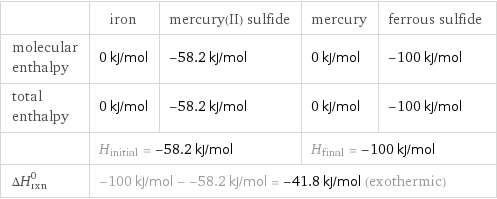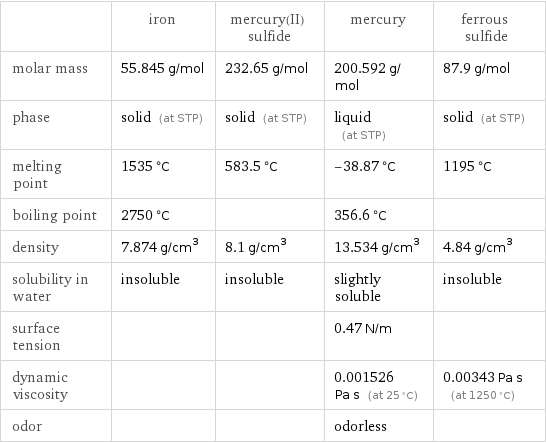Input interpretation

Fe iron + HgS mercury(II) sulfide ⟶ Hg mercury + FeS ferrous sulfide
Balanced equation

Balance the chemical equation algebraically: Fe + HgS ⟶ Hg + FeS Add stoichiometric coefficients, c_i, to the reactants and products: c_1 Fe + c_2 HgS ⟶ c_3 Hg + c_4 FeS Set the number of atoms in the reactants equal to the number of atoms in the products for Fe, Hg and S: Fe: | c_1 = c_4 Hg: | c_2 = c_3 S: | c_2 = c_4 Since the coefficients are relative quantities and underdetermined, choose a coefficient to set arbitrarily. To keep the coefficients small, the arbitrary value is ordinarily one. For instance, set c_1 = 1 and solve the system of equations for the remaining coefficients: c_1 = 1 c_2 = 1 c_3 = 1 c_4 = 1 Substitute the coefficients into the chemical reaction to obtain the balanced equation: Answer: | | Fe + HgS ⟶ Hg + FeS
Structures

+ ⟶ +
Names

iron + mercury(II) sulfide ⟶ mercury + ferrous sulfide
Reaction thermodynamics
Enthalpy

| iron | mercury(II) sulfide | mercury | ferrous sulfide molecular enthalpy | 0 kJ/mol | -58.2 kJ/mol | 0 kJ/mol | -100 kJ/mol total enthalpy | 0 kJ/mol | -58.2 kJ/mol | 0 kJ/mol | -100 kJ/mol | H_initial = -58.2 kJ/mol | | H_final = -100 kJ/mol | ΔH_rxn^0 | -100 kJ/mol - -58.2 kJ/mol = -41.8 kJ/mol (exothermic) | | |
Equilibrium constant
![Construct the equilibrium constant, K, expression for: Fe + HgS ⟶ Hg + FeS Plan: • Balance the chemical equation. • Determine the stoichiometric numbers. • Assemble the activity expression for each chemical species. • Use the activity expressions to build the equilibrium constant expression. Write the balanced chemical equation: Fe + HgS ⟶ Hg + FeS Assign stoichiometric numbers, ν_i, using the stoichiometric coefficients, c_i, from the balanced chemical equation in the following manner: ν_i = -c_i for reactants and ν_i = c_i for products: chemical species | c_i | ν_i Fe | 1 | -1 HgS | 1 | -1 Hg | 1 | 1 FeS | 1 | 1 Assemble the activity expressions accounting for the state of matter and ν_i: chemical species | c_i | ν_i | activity expression Fe | 1 | -1 | ([Fe])^(-1) HgS | 1 | -1 | ([HgS])^(-1) Hg | 1 | 1 | [Hg] FeS | 1 | 1 | [FeS] The equilibrium constant symbol in the concentration basis is: K_c Mulitply the activity expressions to arrive at the K_c expression: Answer: | | K_c = ([Fe])^(-1) ([HgS])^(-1) [Hg] [FeS] = ([Hg] [FeS])/([Fe] [HgS])](../image_source/8504018958c1b3d0d9f9809525fd8770.png)
Construct the equilibrium constant, K, expression for: Fe + HgS ⟶ Hg + FeS Plan: • Balance the chemical equation. • Determine the stoichiometric numbers. • Assemble the activity expression for each chemical species. • Use the activity expressions to build the equilibrium constant expression. Write the balanced chemical equation: Fe + HgS ⟶ Hg + FeS Assign stoichiometric numbers, ν_i, using the stoichiometric coefficients, c_i, from the balanced chemical equation in the following manner: ν_i = -c_i for reactants and ν_i = c_i for products: chemical species | c_i | ν_i Fe | 1 | -1 HgS | 1 | -1 Hg | 1 | 1 FeS | 1 | 1 Assemble the activity expressions accounting for the state of matter and ν_i: chemical species | c_i | ν_i | activity expression Fe | 1 | -1 | ([Fe])^(-1) HgS | 1 | -1 | ([HgS])^(-1) Hg | 1 | 1 | [Hg] FeS | 1 | 1 | [FeS] The equilibrium constant symbol in the concentration basis is: K_c Mulitply the activity expressions to arrive at the K_c expression: Answer: | | K_c = ([Fe])^(-1) ([HgS])^(-1) [Hg] [FeS] = ([Hg] [FeS])/([Fe] [HgS])
Rate of reaction
![Construct the rate of reaction expression for: Fe + HgS ⟶ Hg + FeS Plan: • Balance the chemical equation. • Determine the stoichiometric numbers. • Assemble the rate term for each chemical species. • Write the rate of reaction expression. Write the balanced chemical equation: Fe + HgS ⟶ Hg + FeS Assign stoichiometric numbers, ν_i, using the stoichiometric coefficients, c_i, from the balanced chemical equation in the following manner: ν_i = -c_i for reactants and ν_i = c_i for products: chemical species | c_i | ν_i Fe | 1 | -1 HgS | 1 | -1 Hg | 1 | 1 FeS | 1 | 1 The rate term for each chemical species, B_i, is 1/ν_i(Δ[B_i])/(Δt) where [B_i] is the amount concentration and t is time: chemical species | c_i | ν_i | rate term Fe | 1 | -1 | -(Δ[Fe])/(Δt) HgS | 1 | -1 | -(Δ[HgS])/(Δt) Hg | 1 | 1 | (Δ[Hg])/(Δt) FeS | 1 | 1 | (Δ[FeS])/(Δt) (for infinitesimal rate of change, replace Δ with d) Set the rate terms equal to each other to arrive at the rate expression: Answer: | | rate = -(Δ[Fe])/(Δt) = -(Δ[HgS])/(Δt) = (Δ[Hg])/(Δt) = (Δ[FeS])/(Δt) (assuming constant volume and no accumulation of intermediates or side products)](../image_source/74e816d1c45821856345a9e0af97dc9c.png)
Construct the rate of reaction expression for: Fe + HgS ⟶ Hg + FeS Plan: • Balance the chemical equation. • Determine the stoichiometric numbers. • Assemble the rate term for each chemical species. • Write the rate of reaction expression. Write the balanced chemical equation: Fe + HgS ⟶ Hg + FeS Assign stoichiometric numbers, ν_i, using the stoichiometric coefficients, c_i, from the balanced chemical equation in the following manner: ν_i = -c_i for reactants and ν_i = c_i for products: chemical species | c_i | ν_i Fe | 1 | -1 HgS | 1 | -1 Hg | 1 | 1 FeS | 1 | 1 The rate term for each chemical species, B_i, is 1/ν_i(Δ[B_i])/(Δt) where [B_i] is the amount concentration and t is time: chemical species | c_i | ν_i | rate term Fe | 1 | -1 | -(Δ[Fe])/(Δt) HgS | 1 | -1 | -(Δ[HgS])/(Δt) Hg | 1 | 1 | (Δ[Hg])/(Δt) FeS | 1 | 1 | (Δ[FeS])/(Δt) (for infinitesimal rate of change, replace Δ with d) Set the rate terms equal to each other to arrive at the rate expression: Answer: | | rate = -(Δ[Fe])/(Δt) = -(Δ[HgS])/(Δt) = (Δ[Hg])/(Δt) = (Δ[FeS])/(Δt) (assuming constant volume and no accumulation of intermediates or side products)
Chemical names and formulas

| iron | mercury(II) sulfide | mercury | ferrous sulfide formula | Fe | HgS | Hg | FeS name | iron | mercury(II) sulfide | mercury | ferrous sulfide IUPAC name | iron | thioxomercury | mercury |
Substance properties

| iron | mercury(II) sulfide | mercury | ferrous sulfide molar mass | 55.845 g/mol | 232.65 g/mol | 200.592 g/mol | 87.9 g/mol phase | solid (at STP) | solid (at STP) | liquid (at STP) | solid (at STP) melting point | 1535 °C | 583.5 °C | -38.87 °C | 1195 °C boiling point | 2750 °C | | 356.6 °C | density | 7.874 g/cm^3 | 8.1 g/cm^3 | 13.534 g/cm^3 | 4.84 g/cm^3 solubility in water | insoluble | insoluble | slightly soluble | insoluble surface tension | | | 0.47 N/m | dynamic viscosity | | | 0.001526 Pa s (at 25 °C) | 0.00343 Pa s (at 1250 °C) odor | | | odorless |
Units
